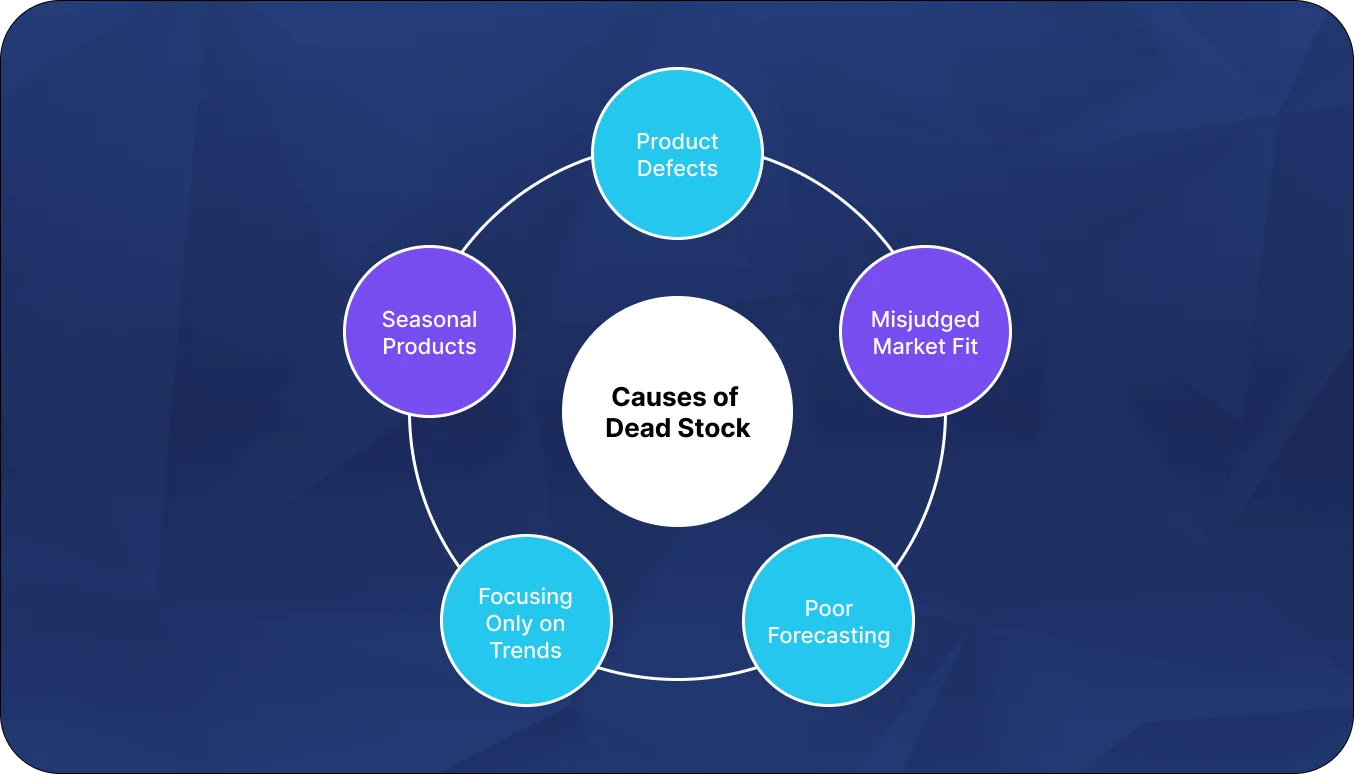Dead stock, a term often overlooked in the retail industry, can have a significant impact on a business’s financial health. This article delves into the intricacies of dead stock, exploring its definition, the challenges it poses, and effective strategies for inventory management to mitigate its adverse effects.
Have you ever wondered:
- How does dead stock impact a business’s profitability?
- What are the common causes of dead stock accumulation?
- Are there effective strategies to prevent and minimize dead stock?
Let’s explore these questions and uncover the secrets to successful inventory management.
What is Dead Stock?
Dead stock refers to unsold inventory (or inventory that isn’t selling). It sits on shelves or in warehouses. Unlike regular stock, dead stock inventory doesn’t move. It’s not being sold, and no one wants to buy it. In short, dead stock is inventory that’s no longer in demand.
It’s not just a retail problem. Dead stock can happen in any industry—and it’s RISKY!
What are the Causes of Dead Stock?
Dead stock items don’t just appear out of nowhere. There are specific reasons why it occurs. Let’s look at some of the common causes:
- Seasonal Products: Some items are only in demand during certain times of the year. Think of winter coats or Christmas decorations. Once the season is over, these products might not sell, leaving you with dead stock.
- Focusing Only on Trends: Trends can be unpredictable. What’s popular today might not be tomorrow. Businesses that heavily invest in trending items may find themselves with unsellable stock once the trend fades.
- Poor Forecasting: Accurate forecasting is crucial. If a business misjudges customer demand, they might end up with too much inventory. This excess inventory can quickly become dead stock if it doesn’t sell.
- Product Defects: If a product has defects or doesn’t meet quality standards, customers will avoid buying it. Even a small flaw can lead to dead stock.
- Misjudged Market Fit: Sometimes, businesses launch products that don’t fit their target market. This misalignment leads to poor sales, turning that inventory into dead stock.
Impact of Dead Stock on Your Business
Dead stock has several negative impacts on a business. Understanding these effects is crucial for managing and preventing dead inventory.

- Tied-Up Capital: Obsolete stock ties up your money. Every unsold item represents cash flow that could be used elsewhere. Instead, that money is locked away in inventory that isn’t generating revenue.
- Increased Storage Costs: Storing dead stock costs money. You need valuable warehouse space, whether it’s in a warehouse or on a retail shelf. The longer dead stock sits, the more you’ll pay in storage costs.
- Decreased Profit Margins: Dead stock often leads to markdowns. To move unsold inventory, businesses may slash prices. These discounts eat into profit margins, reducing overall profitability.
- Brand Image Issues: Dead stock can affect how customers perceive your brand. If you constantly have old, unsellable stock, customers might view your brand as outdated or unpopular. This perception can harm your reputation.
How to Identify Dead Stock Early?
The key to managing dead stock is early identification. The sooner you spot potential dead stock, the better you can manage it. Here’s how to identify dead stock in your inventory:
- Monitor Inventory Turnover: Keep an eye on how quickly your products are selling. Slow-moving items are a red flag. If a product hasn’t sold in a while, it might become dead stock.
- Analyze Sales Data: Use data to track sales trends. Identify which products are consistently underperforming. Historical sales data can help predict future dead stock.
- Regular Inventory Audits: Conduct regular inventory checks. Compare your physical stock to your sales records. This practice helps you spot unsold items and take action before they become dead stock.
- Watch Seasonal Trends: Pay attention to seasonal items. Once the season ends, evaluate your inventory. If certain products didn’t sell as expected, they might need special attention to avoid becoming dead stock.
Strategies to Get Rid of Dead Stock
Dead stock is a challenge, but it’s not insurmountable. There are several strategies you can use to manage and reduce dead stock in your business:
Discounting and Clearance Sales
One of the most common ways to move dead stock is through discounts. Clearance sales can attract bargain hunters. Even though you may not make a profit, you’ll free up space and cash, and get rid of dead stock.
Bundles and Promotions
Combine dead stock with popular items in a bundle. This strategy can make the dead stock more appealing. Customers might be willing to buy a less popular item if it’s paired with something they want.
Donate Unsold Inventory
If you can’t sell dead stock, consider donating it. This approach not only frees up space but also provides tax benefits. Plus, it can improve your brand’s image by showing a commitment to community support.
Sell on Discount to Retailers
Some retailers specialize in selling discounted goods. Consider selling your dead stock to them at a reduced price. It’s a way to recoup some of your costs while clearing out unsellable inventory.
Repurpose or Recycle
Get creative with your dead stock. Can it be repurposed or recycled? For example, textiles can be turned into rags and outdated electronics can be recycled for parts. This approach minimizes waste and can sometimes generate revenue.
Review and Adjust Purchasing Strategies
Take a close look at how you’re purchasing inventory. If dead stock is a recurring issue, you might need to adjust your buying strategies. Purchase smaller quantities or negotiate for more flexible terms with suppliers.
Improve Demand Forecasting
Invest in better forecasting tools. Accurate demand forecasting can help you avoid overproduction and reduce the risk of dead stock. Data-driven insights are key to making informed inventory decisions.
Preventing Dead Stock in the Future
Prevention is always better than cure. By taking proactive steps, you can reduce the likelihood of dead stock in the future:
Adopt a Lean Inventory Approach
Lean inventory management focuses on minimizing excess. Keep only what you need and reduce overstocking. This approach reduces the risk of dead stock.
Implement Just-In-Time (JIT) Inventory
JIT inventory means ordering stock as close to the time of sale as possible. This strategy reduces the amount of unsold inventory and minimizes dead stock risks.
Use Inventory Management Software
Invest in good inventory software. It can help you track inventory levels, sales patterns, and demand forecasts. This data is crucial for making smart inventory decisions.
Stay Agile with Market Trends
The market can change quickly. Stay agile by regularly reviewing market trends. Adjust your inventory accordingly to avoid investing heavily in products that might lose popularity.
Collaborate with Suppliers
Work closely with your suppliers. Establish flexible agreements that allow for returns or exchanges. This collaboration can help you manage excess inventory before it turns into dead stock.
Conduct Regular Product Reviews
Regularly assess your product lineup. Identify items that are underperforming and decide if they should be phased out. This review helps keep your inventory fresh and in demand.
Examples of Dead Stock Management
Learning from others can be valuable. Let’s look at some real-life examples of how businesses have managed dead stock effectively:
Fashion Retailers
Fashion is a fast-moving industry, and dead stock is a common issue. Many retailers, like Zara, use a fast fashion model. They produce in smaller batches and replenish based on demand. This approach minimizes dead stock by staying close to current trends and reducing excess inventory.
Electronics Companies
Technology evolves quickly, leading to potential dead stock. Companies like Apple manage this by limiting production runs of certain products and offering trade-in programs. These strategies help manage older inventory while promoting new products.
Bookstores
Bookstores often face dead stock, especially with niche or less popular titles. Some, like independent bookstores, use creative marketing and community events to drive sales of unsold books. Others may offer buyback programs or donations to schools and libraries to clear dead stock.
Grocery Stores
Dead stock in grocery stores often involves perishable items. Stores like Whole Foods focus on reducing waste by closely monitoring inventory and donating unsellable but edible items to food banks. They also use dynamic pricing to sell items nearing their expiration date.
The Role of Technology in Managing Dead Stock
Technology plays a significant role in managing and reducing dead stock. Here are some ways businesses can leverage technology:
Automated Reordering
Some systems automatically reorder stock based on sales data. This automation ensures that businesses only order what they need, reducing excess inventory.
E-commerce Analytics
Online stores can use e-commerce analytics to track customer behavior. Understanding what products customers are viewing, adding to carts, or abandoning can provide insights into potential dead stock. Businesses can then adjust their inventory or marketing strategies accordingly.
Supply Chain Management Software
Efficient supply chain management is crucial for preventing dead stock. Software that optimizes supply chain processes can help businesses align their production and distribution with actual demand, minimizing excess inventory.
Conclusion
Dead stock is a challenge that every business faces at some point. However, with the right strategies and tools, it’s manageable. Understanding the causes of dead stock, its impact on your business, and how to identify it early are the first steps. Dead stock doesn’t have to be a burden; with the right approach, you can keep your inventory fresh, your customers happy, and your business thriving.
Take the Next Step
Revamp your inventory with AI-powered Impact Analytics InventorySmart™. Optimize stock levels, reduce dead stock, and boost profits effortlessly. Transform your inventory management today!
Frequently Asked Questions
How can I identify dead stock early?
Monitor inventory turnover, analyze sales data, and conduct regular inventory audits. Slow-moving items are potential dead stock.
What are effective strategies to reduce dead stock?
Use discounts, bundle products, donate unsellable items, or sell to discount retailers. These methods help clear out dead stock.
How can I prevent dead stock from accumulating in the future?
Adopt lean inventory practices, use just-in-time ordering, and stay agile with market trends to minimize the risk of dead stock.





